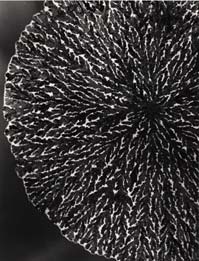

The mechanical, electrical and magnetic properties of the material depends on the way of its preparation. From the old days smiths know that in order to make steel hard it should be quenched. If instead it is anhealed i.e. cooled down at slow rate it becomes plastic. Today it is possible to study the alloys under electron microscope. Israeli scientistic Yossi Lereah looked at the thin films of amorphous alloy of Ge and Al under high-power electron microscope (See Fig .2.9). When he heated his sample to 4000 he saw the beautifull flowers (See Fig .2.9) of Ge start to grow within the patches of Al that appeared all over the place. This process is know as phase segregation.


But in the his process, phase segregation happens together with crystallization of both compounds Al and Ge. The Al crystal start to grow from the amorphous phase as soon as the temperature goes above the glass transition temperature, from little crystals of pure Al that are always present in the amorphous phases. The problem is that Al crystals cannot grow if the concentration of Ge exeeds certain solubility limit. What is amazing in Lereah experiment is that Ge can diffuse inside the crystal and precipitate inside to form its own crystallite aggregate. This process is known as diffusion limited aggregation which results in branchy aggregates, sometimes ressembling trees or bacteria colonies. Our Universal program allows you to simulate formation of amorphous substances in quenching the crystallization together with phase segregation during diffusion limited aggregation. in http://polymer.bu.edu/ sergey/yossi.html you will be able to see a simulation of this process. Initially the lattice is filled with green and red pixels of ceratin concentration, representing Al and Ge atoms respectively. At the top of the layer of Al crystal (white) and Ge aggregate (pink) the Al crystal start to grow from the amorphous alloy boundary and occasionaly Ge crystals if the concentration of Ge inside Al is larger than certain solubility limit. No growth at this point of the interface can occur until Ge atoms diffuse throw the Al crystal and precipitate at the ge aggregate inside. See the pink Ge branches growing inside the white Al crystal.
|
~ You can simulate different process using different initial configuration.
You can simulate different processes using this initial configuration. You
can modify the initial configuration by
~ After you change the initial file Alloy.txt:
1. Open Universal Application. Press on Open Simulation and select
Alloy.txt. Change the temperature to 10 to randomize the initial configuration
and wait 100-1000 units time. save the text file as a new starting file
2. Quench the random initial configuration to low temperature 0.1, to do that
Press Stop- Change Temperature, set new temperature in the field
`temperature' and press Ok . Check Heat Batht. Click Heat Bath
Options and make sure that the heat-bath is 0.1 and the heat exchange coefficient
has value 1.
3. Start to record the movie of your simulation selecting Save Movie
from the menu and averaging for simulations selecting Save Data. The
time step of the movie should not be too small, otherwise you will fill up
the disk space. The quenching time (before the potential energy of the system
stops changing) is about 10000-20000 unit time so the time step of the movie should not be less than 10-20 steps (1000 frames of the movie of 1000 atoms will take 6 MB). The same is
true for the Data fill. Moreover if you make time interval too small the data
will fluctuate a lot. Averaging over time interval which is performed while
saving data reduce the temporal fluctuations. You can perform time averaging
while running your simulation for arbitrary time interval by selecting Averaging
for simulations from option menu. Press reset in order to start averaging
for a new time interval. The parameters that you might calculate are temperature,
volume, pressure, mass, density, potential energy, total energy, N0
of type 1, N0 of type 2, Kine E of type 1, Kine E of type 2, density
of type 1, density of type 2.
4. After quenching your system for certain time (the potential energy of amorphous
stops to decrease) you may start to annheal it by raising the heat bath temperature
to e.g 0.3 and setting the heat bath coefficient to e.g 0.001.
~ In such a way we prepare different movies we present here.
5. See our movies.